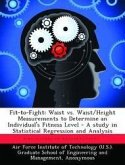Physical fitness is absolutely essential for effective military service. Recognizing that since the Air Force's inception its fitness efforts have failed to produce a fit force, then-chief of staff Gen John P. Jumper became the catalyst for change. In a series of "Chief's Sight Pictures" in 2003, he unveiled "Fit to Fight," a new program intended to embed fitness in the culture of the service. "The amount of energy we devote to our fitness programs is not consistent with the growing demands of our warrior culture. It's time to change that," the general declared. It was indeed time, and five years into the new program, it is time to ask what, if anything, has changed. This research study attempts to answer the question, is the Air Force "Fit to Fight" Fitness Program admin or ethos? In other words, has it succeeded in creating a fitness culture? The author begins by exploring fitness in the Air Force today to establish a baseline for discussion. Then, after describing salient features of renowned social psychologist Edgar H. Schein's Organizational Culture and Leadership model, he uses the Schein model as a conceptual framework to analyze the extent to which fitness has been embedded in the service's culture.
Hinweis: Dieser Artikel kann nur an eine deutsche Lieferadresse ausgeliefert werden.
Hinweis: Dieser Artikel kann nur an eine deutsche Lieferadresse ausgeliefert werden.








